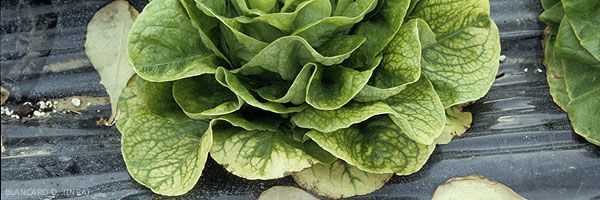
Beet western yellow virus (BWYV)
- classification: Luteoviridae, Polerovirus
Identified on lettuce in the 1950s in the United States, the Beet western yellow virus (BWYV) was subsequently isolated in Great Britain (1970), France (1977) and all of Europe, Israel, Australia, Japan ... Its difficult identification (non-mechanically transmissible virus, delicate serological detection) delayed its detection. Symptoms of the disease have therefore long been attributed to other causes and in particular to mineral deficiencies. Today it is rife in the open field in all production areas, but its damage is particularly serious during periods of the year with strong light and / or in sunny regions.
The name of " summer jaundice " has often been given to the disease. All types of lettuce are sensitive, the "butter" types selected for their resistance to bolting are more particularly affected. The consequences of the disease are generally less serious, in terms of marketable plants, in the batavia type. The same is true for anthocyanin varieties when they are not infected too early. Escarole and curly chicory, like endive chicory, are sensitive, but the damage caused in autumn cultivation generally appears to be minor.
BWYV is transmitted by aphids and restricted to the plant phloem (Figure 1). It affects major cultivated species around the world such as beetroot, cabbage, rapeseed, soybeans ... It is one of the most serious viruses in Europe on lettuce grown in the open field.
| Figure 1 |
The fight against this virus is, at the present time, very difficult, in particular on vegetable crops.
A recent study was carried out on beet in order to better understand the biological and molecular variability of BWYV, the virus responsible for moderate jaundice in this species. It has in fact made it possible to highlight 3 distinct viral species recently submitted to the ICTV:
- le Beet mild yellowing virus (BMYV) ;
- le Beet chlorosis virus (BChV) ;
- Le Brassica yellowing virus (BrYV).
Only BMYV would infect lettuce; it has, moreover, already been described in Germany on this plant.





